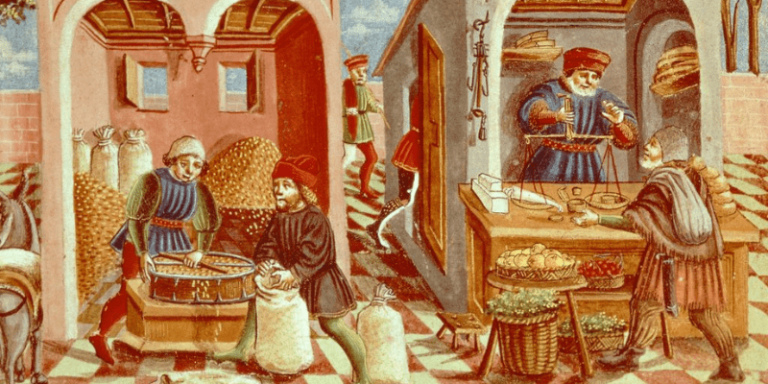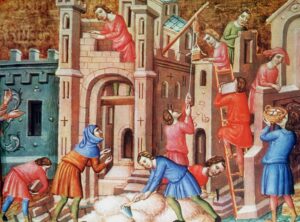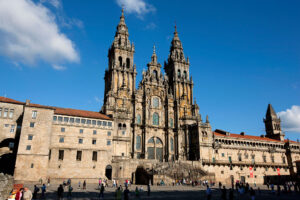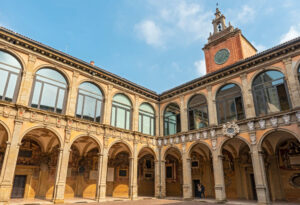The Medieval Warm Period: Did It Save Europe From the Dark Ages?
The history of Europe shows that times of warming were good and that the cold years brought famine, plague, and war.
By: Caroline Adana | June 10, 2021 | 633 Words

Grains and fruit store, miniature from a Lombard manuscript, 15th Century. (Photo by DeAgostini/Getty Images)
After the cold spell of the Dark Ages and the Justinian plague, evidence suggests the climate in Europe warmed. This created what people now call the Medieval Warm Period (MWP), which some suggest lasted from about 950 to 1250.

Middle age, construction of a church in the 14th century, masons and carpenters are at work. Medieval miniature, Europe, approx. 1350. (Photo by Fototeca Gilardi/Getty Images)
The idea of the MWP is controversial among scientists and historians, with many arguing about how warm it was and where temperature changes may have occurred – or if they even did. Still, several studies show that Europe enjoyed reliably warm conditions during the period.
Population Growth
The theory is that warm summers and longer growing seasons meant more food from larger crops. The beginning of the MWP in Europe, therefore, is thought to have supported significant population growth. The climate was so warm that it was possible to grow wine grapes in Scotland, now known for its cold and somewhat harsh weather.
Norse explorers founded a colony on Greenland where they were able to grow food. Today, it is too cold there for agriculture. One of these explorers was Leif Erikson. He managed to sail with his team to America nearly 500 years before Christopher Columbus.

Santiago de Compostela Cathedral (Photo by: Andia/Universal Images Group via Getty Images)
Great Cathedrals
In the Medieval period, Christianity was spreading to all corners of Europe. The large crops made the landowners wealthy, and they spent it on building extravagant cathedrals.
One of the most famous buildings from this age was the Santiago de Compostela Cathedral in Spain. It was started in 1075 and completed in 1211. Another famous cathedral built during this period was Notre-Dame de Paris. It was started in 1163 and finished in 1345. Today, millions of people visit these Medieval buildings every year.
University
The Christians did not only build cathedrals. They also founded universities. In these universities, students learned theology and knowledge of the natural world. The first was founded in Bologna, Italy, in 1088.
These institutions were of great importance for the future of the West and the entire world. One scholar who was educated in university was Thomas Aquinas, a leading thinker of the Renaissance, the era that would follow the Medieval period.

University of Bologna (Photo by: Petr Svarc/UCG/Universal Images Group via Getty Images)
The Black Death
Around 1250, there were reports that sea ice was building up in the North Atlantic. By 1300, reliable warm summers were gone. Europe was once again falling into a cool period known as the Little Ice Age. In 1315, Europe experienced its first great famine in hundreds of years.
Once more, pandemics returned to Europe. In 1346, the Black Death arrived. It was the same type of bacteria that had killed millions during the reign of Justinian, today known as the bacterium Yersinia pestis, which causes plague. While modern scientists realize the bacteria is carried by infected fleas on rats and other small rodents, Medieval societies had no idea what caused it. It raged for years and killed an estimated 75 million to 200 million people in Eurasia and North Africa during that time, which amounted to about 20% of the world population. In Europe, the Black Death was even deadlier. Between 30% and 60% of the continent’s population died. By comparison, COVID-19 has so far killed 0.05% of the people in the world.
Cool Climate, Hot Philosophy
The end of the Medieval Warm Period began centuries of famine, plagues, and war in Europe. Unlike previous times of hardship, Europe had spent its warm period rediscovering the great thinkers of the ancient world. Therefore, despite all the death and suffering, Europe still advanced in technology and knowledge.
















